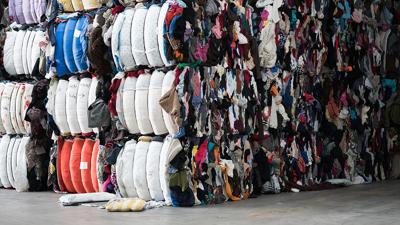Chemical Fibers International 4/2022

Prof. Stefan Schlichter
The new EU Textile Strategy and the desire of consumers for responsibly produced and reused textiles are driving new concepts in textile recycling. Holistic action along the entire textile value chain must, however, be oriented to technical realities, which is why some frequently expressed theses require correction.
1. Recycling is limited to apparel textiles
Textiles are more than just clothing. Technical textiles, textile floorcoverings, mattresses and other home textiles must be as equally integrated into the recycling systems of the future as composites, hygiene textiles and construction and geotextiles. Overall, taking all of these products into account, the volume of end-of-life textiles is probably more than twice the size of just the apparel market. Unfortunately, precise figures are missing, which makes the development of suitable recycling concepts difficult. Most importantly, these products are also a good target market for recycled textile products and can absorb significant amounts of secondary materials. Above all, we need collection systems (and the related volume figures) for all textiles in order to find completely satisfactory and efficient solutions.
Textiles are more than just clothing. Technical textiles, textile floorcoverings, mattresses and other home textiles must be as equally integrated into the recycling systems of the future as composites, hygiene textiles and construction and geotextiles. Overall, taking all of these products into account, the volume of end-of-life textiles is probably more than twice the size of just the apparel market. Unfortunately, precise figures are missing, which makes the development of suitable recycling concepts difficult. Most importantly, these products are also a good target market for recycled textile products and can absorb significant amounts of secondary materials. Above all, we need collection systems (and the related volume figures) for all textiles in order to find completely satisfactory and efficient solutions.
2. The future lies in textiles made from one material
Textiles live from the diversity of materials; blends are the driving force of innovation in textile design in order to be able to present the desired and appropriate functionality of the products. Fashion needs the innovative power of different designs; technical textiles generate their multi-functionality from the combination of different materials. Single-material systems would make smart textiles and composite materials impossible to achieve, thus preventing intelligent textile solutions as well as resource-saving lightweight products. Modern recycling systems must face the challenges of such products and create innovative solutions through design-for-recycling approaches that define functionality and recycling not as a contradiction but as a challenge.
Undeniably, unnecessary material diversity must of course be avoided if the function does not absolutely require it. This applies not only to the basic materials but to all haberdasheries like zippers, specification labels or functional elements… However, above all, it is important to redefine the bonding and coating systems and to create intelligent systems that also enable the bonds to be detached (debond on demand).
We need to learn how to create recycling systems that enable effective recycling even with multi-material systems without first completely separating all materials. Fiber blends can, as first trials in our Recycling Atelier show, certainly be recycled together and reassembled with virgin materials in the design process to create products that are in demand.
3. Chemical recycling will be the only system of the future
In a holistically sensible recycling strategy, the waste pyramid specifies the gradation of the various recycling concepts. The best quality recovery lies in the greater use of reuse (also, and especially for, technical textiles). This starts with improved return systems and the building of an attractive re-sale strategy. We need to make greater use of this and also integrate textiles not previously covered into our collection and return systems.
Mechanical recycling also offers considerable potential for more effective utilization, which must be exploited, especially since industrial maturity is already in place today. With improved quality assurance systems and newly coordinated process control, quality loss can be effectively countered as long as the fiber still has sufficient length for reuse.
Without a doubt, chemical recycling has great potential for the future, but considerable research efforts will be needed to create systems that are ready for industrial use and meet all economic and ecological requirements. The major obstacle for a short-term introduction of chemical recycling is the still missing industrial maturity compared to mechanical recycling.
The various recycling concepts should therefore not be seen primarily in competition with each other, but should be used in a sensible complementary sequence.
Cradle-to-cradle is an effective and sensible principle for a true circular economy. However, it should not be dogmatically defined as the only way to recycle textiles, as the often unavoidable quality losses in recycling prohibit choosing only this path.
Textile design creativity often allows much more useful products to emerge if we choose creative approaches to realize product use not only in a closed loop, but also to direct it to other application scenarios.
5. Recycling is based only on technically innovative solutions
Without question, technical innovations are the driver for developing new processes. However, the focus must first be on the development of new products to ensure the triad of technical, economic and ecological meaningfulness of the products. This then forms the basis for the industrial upscaling of recycling processes based on improved process technology.
Stefan Schlichter
Managing Director
Institut für Textiltechnik Augsburg gGmbH
Augsburg/Germany
Managing Director
Institut für Textiltechnik Augsburg gGmbH
Augsburg/Germany



